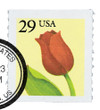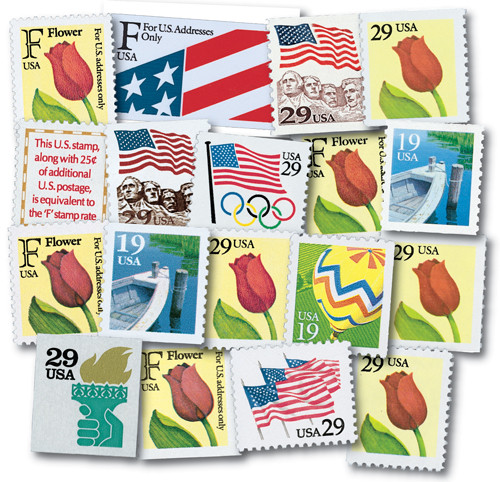
# 2525 - 1991 29c Flower, rouletted coil
US #2525
1991 Flower
- Rouletted perforations
- Same design as rate-change stamp issued earlier in the year
- Issued in three formats
Category of Stamp: Definitive
Value: 29¢
First Day of Issue: April 16, 1991
First Day City: Rochester, New York
Quantity Issued: 1,000,000,000
Printed by: J.W. Fergusson & Sons for Stamp Venturers
Printing Method/Format: Photogravure, Coils of 100 from printing cylinders of 429 (13 across, 33 down)
Perforations: 10 (rouletted)
Reason the stamp was issued: This flower stamp was issued following a rate change in 1991.
About the stamp design: The red tulip against a yellow background was first used for non-denominated stamps when rate changes were put in place. The design was the work of Wallace Marosek, who created the painting while he was an art student at Yale University.
About the Printing Process: This stamp was issued with “slit perforations” according to the USPS, commonly called rouletting. Straight line cuts were placed between stamps rather than holes made during the perforation process. This type of perforation is not common in US postage but had been used on Revenue stamps in the past. Rouletting these coil stamps was an experiment. This type of perforations was less expensive to produce than traditional round perforations.
The stamps were also available in rolls of 10 coils. The USPS called these “stamp sticks.” The coils were connected to one another using a rouletting the Postal Service called “scoring.” The sticks were wrapped in thin paper that was also perforated, so coils could be separated from the sticks at the post office or by a customer with the wrapping intact.
First Day City: Rochester, New York, is nicknamed the Flower City, so it was an appropriate spot for the First Day of Issue of this denominated Flower stamps. There was no official ceremony.
Unusual thing about this stamp: The design for this stamp was first used in 1991 on an “F” rate change stamp. That stamp was issued in sheet, coil, and booklet formats and was produced by three different printers. When the new rate was set at 29¢, the tulip design was again used for these new stamps. This was the first time in US history that the design for a non-denominated stamp was used again on a denominated stamp. The 29¢ stamps were also printed as sheets, booklets, and coils.
US #2525
1991 Flower
- Rouletted perforations
- Same design as rate-change stamp issued earlier in the year
- Issued in three formats
Category of Stamp: Definitive
Value: 29¢
First Day of Issue: April 16, 1991
First Day City: Rochester, New York
Quantity Issued: 1,000,000,000
Printed by: J.W. Fergusson & Sons for Stamp Venturers
Printing Method/Format: Photogravure, Coils of 100 from printing cylinders of 429 (13 across, 33 down)
Perforations: 10 (rouletted)
Reason the stamp was issued: This flower stamp was issued following a rate change in 1991.
About the stamp design: The red tulip against a yellow background was first used for non-denominated stamps when rate changes were put in place. The design was the work of Wallace Marosek, who created the painting while he was an art student at Yale University.
About the Printing Process: This stamp was issued with “slit perforations” according to the USPS, commonly called rouletting. Straight line cuts were placed between stamps rather than holes made during the perforation process. This type of perforation is not common in US postage but had been used on Revenue stamps in the past. Rouletting these coil stamps was an experiment. This type of perforations was less expensive to produce than traditional round perforations.
The stamps were also available in rolls of 10 coils. The USPS called these “stamp sticks.” The coils were connected to one another using a rouletting the Postal Service called “scoring.” The sticks were wrapped in thin paper that was also perforated, so coils could be separated from the sticks at the post office or by a customer with the wrapping intact.
First Day City: Rochester, New York, is nicknamed the Flower City, so it was an appropriate spot for the First Day of Issue of this denominated Flower stamps. There was no official ceremony.
Unusual thing about this stamp: The design for this stamp was first used in 1991 on an “F” rate change stamp. That stamp was issued in sheet, coil, and booklet formats and was produced by three different printers. When the new rate was set at 29¢, the tulip design was again used for these new stamps. This was the first time in US history that the design for a non-denominated stamp was used again on a denominated stamp. The 29¢ stamps were also printed as sheets, booklets, and coils.



















